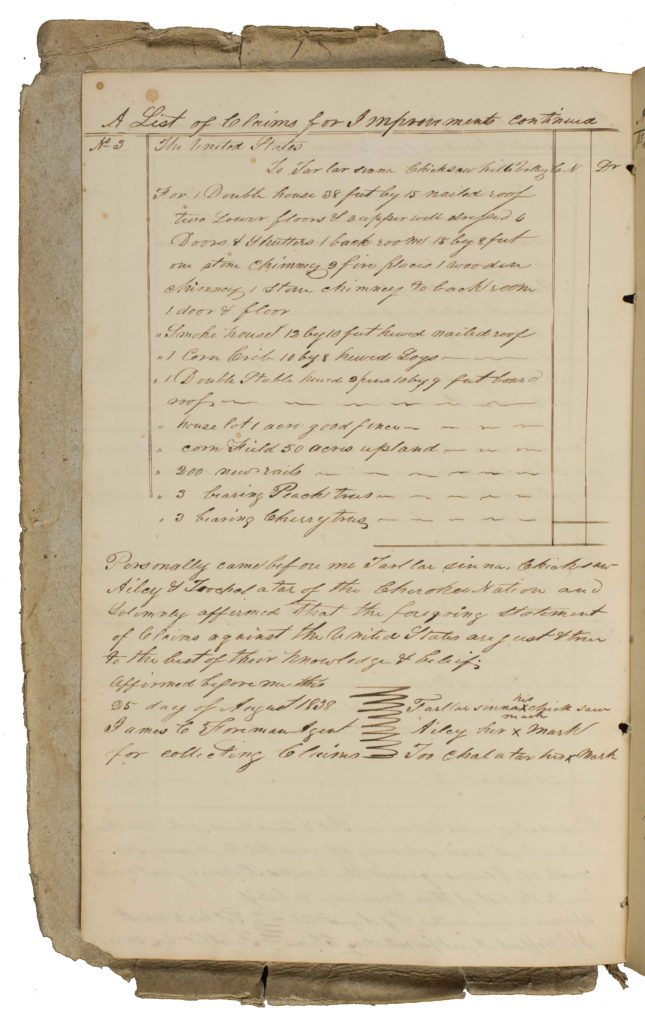- 918.464.2258
- [email protected]
- 412 N. Hwy 100 Suite B, Webbers Falls, OK


This search engine is not a Source. It is a resource to use in research. The original claims are the source.
The main search is for names of Claimants & Witnesses but it also searches comments for some of the claims. Be patient. The database is large. It can take 10-20 seconds for a response. The bar at top of the main page offers separate tools to focus on Locations, Claims Agents, and Cherokee Districts. Additional filtering options exists to narrow after an initial search.
Through the tool of technology images from various repositories have been virtually reassembled into their original order. While great effort was made to locate as many claims as possible, some claims are known to be missing. What is not known is how many claims are missing which are not yet known about. If you happen to find more of these claims please make the National Trail of Tears Association aware of their location so they can be added to this database. The claims were recorded in what so far appears to be totally random order. They are not arranged chronologically, geographically, by Detachment, or by Claims Agent. No original index has been located. Before now, finding a claim for a specific person would have been about as likely as winning the lottery.
These claims were made by Cherokee in the various Removal Camps in the weeks prior to removal. The Claims Agents for these were mostly Cherokee and not employees of the U.S. Government. Except in a small number of cases little mention is made of State and County names. The names of Cherokee Districts, towns, creeks, waterways and rivers were extensively used. There are many resources available online to assist you in determining specifics of the locations named. Many locations are recorded with wildly variant spellings. Think and search using very broad ideas utilizing multiple strategies.
A large number of the Cherokee involved in these claims as claimants or as witnesses used their Cherokee names. Some may have also had an English surname. Some did not. Many Cherokee used or were known by different names. Cherokee names in these claims were written very phonetically and
often with multiple spellings within the same claim. Many Cherokee whose names show up as relations in Eastern Cherokee Applications, but in no other known records, can be found in these claims. It can take a lot of diligence and discipline to find them even with aid of this online search engine. The names of witnesses identified within a claim often differ from their signatures. These may suggest a variant name for some witnesses and an alternate search strategy.
On the surface these appear to be very bare bones claims. Under the surface there are a lot of clues in every claim. You may want to take some time and read several dozen claims just to familiarize yourself with a representative sample. These were claims represent details the Cherokee considered to be of importance.
Suggestions for searching:
When the data was uploaded by the technical providers many Cherokee names, such as Young Turkey, were split into two names, Young and Turkey. Some, but not all, were discovered and corrected. When you read a claim and see that error or omission please add a comment to assist in correcting and improving the database. Make as many notations, additions and corrections as possible. The comments will not be publicly viewable but as time and resources allow, they will be reviewed and the database appropriately updated.
Not all details from every claim were included since the process took many, many years. The importance of some details did not become apparent until later. If you see multiple residences in different locations in a claim which were not originally being indexed, please add them to the comment section. If you see the names of Perpetrators of spoliations and dispossessions against Cherokee, please identify and add those named to the Comments. If you see unique improvements such as Ferries, Taverns, Stands, Courthouses, Council Houses, Churches, Fish Weirs, Mills, Blacksmith Shops, Tanneries, Turnpike, etc. please add them to the Comments. If you see claims involving Slaves in some capacity, also add those to Comments.